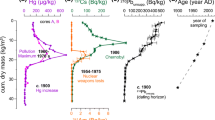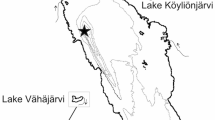Abstract
Phosphorus accumulation rates in depositional zone sediments of Lake Okeechobee were determined in 11 mud-zone cores and two peat-zone cores dated by 210Pb. Although difficulties were encountered in interpreting 210Pb data from some sites, reliable dating of sediments from the mud zone of this shallow lake is possible. Sediment accumulation rates in this zone have increased during the present century by an average of about twofold, and accumulation of organic sediments in the lake during pre-settlement times apparently was much slower than during the past century. Concentrations of all forms of sedimentary P but especially nonapatite inorganic-P and organic-P also have increased since pre-settlement times and especially since about 1940. Annual P accumulation rates in the lake's sediments have increased about fourfold during the 1900s, with most of the increase occurring in the past 40–50 years. The recent accumulation rate of sedimentary P (past ~ 10 years) agrees within a factor of 1.5 with the net retention of P in the lake calculated from published input-output mass balances.
Similar content being viewed by others
References
American Public Health Association, American water Works Association, and Water Pollution Control Federation. 1985. Standard methods for the examination of water and wastewater, 16th ed., Washington, D.C.
Appleby, P. G. & F. Oldfield, 1978. The calculation of lead-210 Dates assuming a constant rate of supply of unsupported 210Pb to the sediment. Catena 5: 1–8.
Appleby, P. G., P. Nolan, D. W. Gifford, M. J. Godfrey, F. Oldfield, N. J. Anderson & R. W. Batterbee, 1986. 210Pb dating by low background gamma counting. Hydrobiologia 141: 21–27.
Appleby, P. G., N. Richardson & P. J. Nolan, 1991. 241Am dating of lake sediments. Hydrobiologia 214: 35–42.
Aumen, N.G. 1995. The history of human impacts, lake management, and limnological research on Lake Okeechobee, Florida (USA). Archiv. Füur Hydrobiol., Adv. Limnol. 45: 1–16.
Berger, J., 1992. The Kissimmee riverine-floodplain system. In Restoration of aquatic ecosystems: science, technology, and public policy, National Academy Press, Washington, D.C.: 477–496.
Binford, M.W., 1990. Calculation and uncertainty analysis of 210Pb dates for PIRLA project sediment cores. J. Paleolimnol. 3: 253–267.
Brenner, M., T. J. Whitmore, M. S. Flannery & M.W. Binford, 1993. Paleolimnological methods for defining target conditions for lake restoration: Florida case studies. Lake Res. Mgmt 7: 209–217.
Brezonik, P. L., E. C. Blancher, V. B. Myers, C. L. Hilty, M.K. Leslie, C. R. Kratzer, G. D. Marbury, B. R. Snyder, T. L. Crisman & J. J. Messer, 1979. Factors affecting primary production in Lake Okeechobee, Florida. Rept. No. 077901, Dept. Env. Eng. Sci., Univ. Florida, Gainesville, FL: 294 pp.
Brooks, H. K., 1974. Lake Okeechobee. In Gleason, P. J. (ed.), Environments of south Florida: present and past. Mem. Miami geol. Soc., Miami, FL: 256–286.
Canfield, D. E. J. & M. V. Hoyer, 1988. The eutrophication of Lake Okeechobee. Lake Res. Mgmt 4: 91–99.
Dean, W. E., Jr., 1974. Determination of carbonate and organic matter in calcareous sediments and sedimentary rocks by loss on ignition: comparison with other methods. J. sed. Petrol. 44: 242–248.
Eakins, J. D. & R. T. Morrison, 1978. A new procedure for the determination of lead-210 in lake and marine sediments. Int. J. appl. Radiation and Isotopes 29: 531–536.
Evans, R. D. & F. H. Rigler, 1980. Measurement of whole lake sediment accumulation and phosphorus retention using lead-210 dating. Can. J. Fish. aquat. Sci. 37: 817–822.
Federico, A. C., K. G. Dickson, C. R. Kratzer & F. E. Davis, 1981. LakeOkeechobeewater quality studies and eutrophication assessment. Tech. Publ. No. 812, S. Florida Water Manag. District, West Palm Beach, FL: 379 pp.
Gleason, P. J. & P. A. Stone, 1976. Prehistoric trophic level status and possible cultural influences on the enrichment of Lake Okeechobee. S. Florida Water Manag. District, West Palm Beach FL: 113 pp.
Hutchinson, G. E., 1957. A treatise on limnology, 1. J. Wiley & Sons, N.Y.
Janus, L. L., D. M. Soballe & B. L. Jones, 1990. Nutrient budget analyses and phosphorus loading goal for Lake Okeechobee, Florida. Verh. int. Ver. Limnol. 24: 538–546.
Joyner, B. F., 1974. Chemical and biological conditions of Lake Okeechobee, Florida, 1969—72. Rept. Invest. 71, Bureau of Geol., Tallahassee, FL: 169 pp.
Kratzer, C. R. & P. L. Brezonik, 1984. Application of nutrient loading models to the analysis of trophic conditions in Lake Okeechobee, Florida. Envir. Mgmt 8: 109–120.
Krishnaswamy, S. & D. Lal, 1978. Radionuclide limnochronology In Lerman, A. (ed.), Lakes, chemistry geology physics. Springer-Verlag: 153–177.
Maceina, M. J. & D. M. Soballe, 1990. Wind-related limnological variation in Lake Okeechobee, Florida. Lake Res. Mgmt 6: 93–100.
MacGill, R. A., S. E. Gatewood, C. Hutchinson & D. D. Walker, 1976. Final report on the special project to prevent eutrophication of Lake Okeechobee. Rept. DSP-BCP-36-76, Div. State Planning, Tallahassee, FL: 340 pp.
Oldfield, F. & P.G. Appleby, 1984. Empirical testing of 210Pbdating models for lake sediments. In Haworth, E. Y. & J. W. G. Lund (eds), Lake sediments and environmental history. Univ. of Minnesota Press, Minneapolis: 93–124.
Reddy, R. M., D. A. Graetz, F. E. Dierberg, P. Sheng, W. C. Huber, C. Pollman & P. L. Brezonik. 1993. Phosphorus dynamics in Lake Okeechobee: executive summary. Univ. of Florida, Dept. Soil Sci., Gainesville, FL: 67 pp.
Schelske, C. L., 1989. Assessment of nutrient effects and nutrient limitation in Lake Okeechobee. Wat. Res. Bull. 25: 1119–1130.
Stoermer, E. F., N. A. Andresen & C. L. Schelske, 1992. Diatom succession in the recent sediments of Lake Okeechobee, Florida, USA. Diatom Res. 7: 367–386.
Tebeau, C. W., 1971. A history of Florida. Univ. of Miami Press, Coral Gables.
Tebeau, C.W., 1974. Exploration and early descriptions of the Everglades, Lake Okeechobee and the Kissimmee River. In Gleason, P. J. (ed.), Environments of south Florida: present and past. Mem. Miami geol. Soc., Miami, FL: 1–7.
Vollenweider, R. A., 1969. Müoglichkeiten und Grenzen elementarer Modelle der Stoffbilanz von Seen. Arch. Hydrobiol. 66: 1–36.
Whitmore, T. J., M. Brenner & C. L. Schelske. 1996. Highly variable sediment distribution in shallow, windstressed lakes: a case for sedimentmapping surveys in paleolimnological studies. J. Paleolimnol. 15: 207–221.
Williams, J. D. H., J. M. Jaquet & R. L. Thomas, 1976. Forms of phosphorus in the surficial sediments of Lake Erie. J. Fish. Res. Bd Can. 33: 413–429.
Williams, J.D.H., J. K. Syers, S. S. Shukla, R. F. Harris& D. E. Armstrong, 1971. Levels of inorganic and total phosphorus in lake sediments as related to other sediment parameters. Envir. Sci. Technol. 5: 1113–1120.
Author information
Authors and Affiliations
Rights and permissions
About this article
Cite this article
Brezonik, P.L., Engstrom, D.R. Modern and historic accumulation rates of phosphorus in Lake Okeechobee, Florida. Journal of Paleolimnology 20, 31–46 (1998). https://doi.org/10.1023/A:1007939714301
Issue Date:
DOI: https://doi.org/10.1023/A:1007939714301




